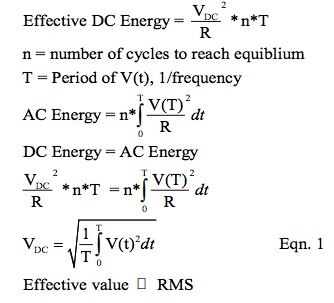|
Dataforth Application Note: RMS Revisited |
| November 2018, MARIETTA, GA ~ |
| Preamble |
|
When we purchase electrical equipment, appliances, light bulbs, motors, heaters and such, somewhere on the “name plate” are some electrical specifications such as voltage, current, frequency, power, etc. We have seen these values for as long as we have been able to read and so we just take them for granted. For AC (the abbreviation for alternating current), the values for voltage and current are always shown as “RMS” values; however, this fact is rarely stated on the name plate. It is assumed everyone knows this. What does RMS really mean? This Application Note will revisit the definition of RMS, show RMS values for various time functions, and explore some interesting RMS measurement issues. Our object here is to provide a better understanding of some of the subtle characteristics of RMS. However, reviewing RMS values for time functions containing random components is beyond the scope of this Application Note. The Appendix contains additional information for your reference, and the reader is encouraged to examine the previous Dataforth Application Note on RMS, AN101. |
| RMS Definition Revisited |
|
Throughout this Application Note, we will consider only periodic functions with no random components. The way to think of the RMS value for a time varying function of voltage or current is to recognize that an RMS value for these time varying items means that the time varying function has the same energy capacity as some value of DC (abbreviation for direct current) voltage or current. The derivation of RMS begins with the requirement that the function of time is “well” behaved (bounded with a finite number of discontinuities), repetitive at some fundamental frequency, and available for as long as needed. A pure mathematician might cringe at these simple requirements but we engineers love them because they apply to most types of voltages and currents we deal with in practice. The experimental apparatus is a pure resistive heating element within a perfectly thermally insulated container. An ideal DC voltage (say 10 volts) is connected to this heater until thermal equilibrium is reached with a final temperature of say Tx degrees.
Next, this DC voltage is removed, the unit is allowed to cool down, and a
time varying voltage, V(t), is applied to the heater until thermal
equilibrium is again reached with a final temperature of, say, Ty degrees.
If Ty = Tx, then the effective value of V(t) = 10 volts (same as the
previous DC value) and so we say the RMS value of V(t) is effectively 10 DC
volts. Why the name RMS? The name comes from the mathematics of this
experiment as follows:
|
| RMS Examples |
|
Perhaps the most familiar time function is the ..... Read the complete application note here To learn more about Dataforth's producst, please click here. |



